OpenBTE: a Solver for ab-initio Phonon Transport in Multidimensional Structures
Abstract
Controlling heat flow at the nanoscales is pivotal to several applications, including thermal energy harvesting and heat management. However, engineering nanostructures is challenging because phonon-boundary interaction, not contemplated by Fourier’s law, must be taken into account. Nondiffusive models, such as the Boltzmann transport equation (BTE), have been successfully employed to capture size effects in complex structures; however, their widespread has been hindered by the limited offer of open-source solvers in this space. We fill this void by introducing OpenBTE, an efficient solver for the steady-state phonon BTE in multidimensional structures. This tool is interfaced to first-principles calculations, thus it unlocks the calculations of thermal-related properties with no fitting-parameters. As an example, we employ OpenBTE to compute the temperature and flux maps, as well as the mode-resolved, effective thermal conductivity of Si membranes with infinite and finite thickness. By unlocking fast nanoscale heat transport simulations, OpenBTE may help accelerate the design of nanomaterials for thermal energy applications.
keywords:
Thermal transport, nanostructuresPROGRAM SUMMARY
Program Title: OpenBTE
Developer’s repository link: https://github.com/romanodev/openbte.git
Licensing provisions: MIT
Programming language: Python
Nature of problem: Ab-initio calculation of thermal transport properties, including temperature and heat flux maps, as well as the effective thermal conductivity of multidimensional nanostructures.
Solution method: We implement the space-dependent, ab-initio Boltzmann transport equation (BTE) for phonons. The first-principles calculation of phonon group velocities, frequencies and scattering times, is delegated to external packages to which OpenBTE is interfaced. The current implementation focuses on a flavor of the BTE that interpolates phonon populations onto their vectorial mean-free-paths, allowing for fast and accurate thermal transport simulations.
Additional comments: Vectorization via NUMPY and parallelization (including with shared memory) with MPI4Py.
1 Introduction
The increasing accuracy of first-principles calculations of heat transport, along with the growing availability of computing resources, has enabled the systematic prediction of lattice thermal conductivity in semiconductors and two-dimensional (2D) materials [1, 2, 3]. If key theoretical developments have solidified our understanding of phonon dynamics at the nanoscales, the fast progress of this field has been unarguably aided by the release of open-source packages. For example, ShengBTE [4] implements the iterative solution of the Boltzmann transport equation (BTE) [5], with force constants computed by first-principles [6, 7]. The tool can be primarily used for either bulk materials or nanowires [8]. Later iterations include AlmaBTE [9], which, among several improvements, features a Monte Carlo solver for superlattices, and FourPhonons [10, 11], a tool that, as the name suggests, can handle four-phonon scattering. Another notable package is Phono3Py [12], where the BTE is solved both within the relaxation time approximation (RTA) and including the full scattering operator [13]. Albeit not strictly required, these tools are mostly used in tandem with super-cell approaches. When a density functional perturbation theory (DFPT) is available for a given material, it is often convenient to compute directly the Fourier-transformed force constants, without resorting to supercells; a prominent package in this space is d3q [14], implemented on top of QUANTUM ESPRESSO [15]. This software also includes the possibility of simulating thin films [16] and coherence effects [17]. In a similar effort, the recently released Kaldo[18] combines the Green-Kubo model and the BTE to take into account material disorder [19].
While the dissemination of these software manifests the increasing excitement around phonon related applications, their focus is primarily on bulk materials or simple geometries. In fact, most phonon dynamics simulations in complex geometries are currently performed by MonteCarlo solvers [20, 21], with a recent implementation provided by MCBTE [22]. Thus, an open-source tool that solves space-dependent heat transport deterministically, i.e. in the same spirit as in bulk calculations, is still pending. We fill this gap by introducing OpenBTE, a solver for the first-principles, multidimensional phonon BTE. Key capabilities include the calculation of the temperature and heat flux maps, as well as the mode-resolve effective thermal conductivity. Ab-initio harmonic and anharmonic properties are delegated to external software. While flexible and straightforward to expand, OpenBTE currently implements the anisotropic-mean-free-path BTE (aMFP-BTE) [23], a method based on the interpolation of the phonon populations onto the vectorial MFP space. This method has shown a 50x speed up with respect to the mode-resolve BTE for thick Si membranes, while not compromising on the accuracy. Furthermore, it scales with constant time with respect to the number of phonon branches, therefore enabling fast simulations of size effects in complex-unit-cell materials, such as bismuth telluride.
The paper is organized as follows. First, we review the model and the assumptions therein, then we provide details on the implemented algorithm and the software’s main modules. An example of a porous Si membrane will follow, and final remarks conclude the paper. We also provides technical implementation details in the appendices. Enabling fast simulations of heat transport in nanostructures, OpenBTE sets out to accelerate the development of thermal-related applications, such as thermal management and thermoelectrics. OpenBTE is released under the GPL-3.0 license and currently hosted on GitHub [24].
2 Model
The steady-state, linearized phonon BTE in the temperature formulation reads [23]
| (1) |
where collectively indicate phonon branch and wave vector, running up to and , respectively. The unknowns are the phonon pseudo-temperatures (referred to hereafter simply as temperatures), connected to the deviational non-equilibrium phonon population via . The mode-specific heat capacity is , with . The terms and are the phonon frequencies and the group velocities, respectively. In this formulation, the thermal flux is given by , where is the volume of the unit cell, and . The term is the energy form of the scattering operator [25]. While we plan to make available the implementation of Eq. 1, currently only the relaxation-time-approximation (RTA) is supported; within the RTA, the RHS of Eq. 1 becomes , leading to
| (2) |
where is the relaxation time, and is the pseudo lattice temperature; this term is evaluated so that energy conservation is satisfied, i.e. , yielding [26].
The simulation domain is a cuboid of size , and with periodic boundary conditions applied throughout by default. A difference of temperature is also enforced along a chosen Cartesian axis. At the walls of the pores, energy conservation leads to , which can be split into incoming and outgoing flux, i.e. ; note that we define , with being the Heaviside function. The boundary condition is imposed to phonons leaving the surface; generally, we have , where () are for outgoing (incoming) phonons, and is a mode-resolved bouncing matrix. However, currently only a simplified model is available, with which we assume that phonons thermalize to a single temperature [20]; this choice corresponds to . Lastly, the effective thermal conductivity, assuming we have imposed the temperature gradient along , reads
| (3) |
Equation 2, when solved iteratively, requires inverting as many linear systems as the number of phonons modes, an endeavour that may easily become prohibitive. To ameliorate the computational effort, we instead implement the recently introduced anisotropic-MFP-BTE (aMFP-BTE), a model based on interpolating the phonon temperatures onto the vectorial MFP space [23]. In practice, instead of solving Eq. 2 times at each iteration, we solve it for a set of vectorial MFPs, , located on a spherical grid. The indices and label the MFP (up to ) and phonon directions (up to ), respectively. As , while not compromising on accuracy, this scheme results in a much faster runtime with respect to the case with mode-resolved resolution, i.e. no interpolation.
3 Implementation
As derived in A, the discretization of aMFP-BTE model in real and momentum space yields the following iterative linear system
| (4) |
where is the stiffness matrix for a given MFP and direction, is associated to the lattice temperature and adiabatic boundary conditions, and represents the perturbation. Once Eq. 4 converges, the effective thermal conductivity is computed as , where is the ballistic thermal conductivity, and is associated to the thermal flux.
The first guess to Eq. 4 is given by the standard heat conduction equation. While it is straightforward to discretize the diffusive equation in orthogonal grids, it becomes convoluted for unstructured meshes. In OpenBTE, we use the approach described in [27], where the non-orthogonal contribution of the flux is treated explicitly, i.e. it depends on previous solutions. The resulting system, analogously to Eq. 4, is an iterative linear system,
| (5) |
where arises from the non-orthogonality of the mesh. Note that in Eq. 4 and in Eq. 5 are not related. The same applies with the terms sharing the same basename in these two equations. The derivation of Eq. 5 is given in B.
Equation 4 entails, for each iteration , the inversion of matrices, whose size is the number of volumes in the computational domain. To enhance the computational efficiency, three distinct strategies have been put in place. First, by noting that the stiffness matrix does not depend on , we are able to compute LU factorizations for the first iteration, and reuse them until convergence. Another major speed up is achieved by vectorizing the assembly of the stiffness matrices, while also exploiting their sparsity. Lastly, for each , Eq. 4 consists of a set of independent problems, thus it can be trivially parallelized [28]; to this end, we assign a set of phonon directions to each core (), while the indices run serially. The implementations of these three methods rely on SCIPY, NUMPY [29] and MPI4PY [30], respectively.
When vectorization and parallelization are both used, we may save memory by noting that, as shown in A, the stiffness matrices have the form ; thus vectorization can be done only for , while is assembled on the fly right before LU factorization. Similar arguments hold for and . The overall methodology is summerized in Algorithm 1, where, for readability, only has been expanded upon.
4 Workflow
The easiest way to run OpenBTE is to use it as a module in Python. A sketch for the workflow is illustrated in Fig. 1. The core module is Solver, which runs both the heat conduction equation as a first guess to Eq. 4 and all subsequent iterations, outlined in Algorithm 1. Before invoking it, though, it is necessary to define the material’s internal boundaries using the Geometry module, and bulk-related data via the Material module. The latter is the interface to external packages. Once the simulation is finalized, results can be plotted using the Plot module. Note that OpenBTE follows a pure functional approach, where data is simply stored as dictionaries. Each module is expanded upon in the next sections.
 \cprotect
\cprotect
5 Material
The Material module converts mode-resolved bulk data, , and , into the spherically-resolved quantities and . The input files, rta.npz, are created by postprocessing data obtained by external packages. Currently, OpenBTE provides interfaces to AlmbaBTE [9] and Phono3Py [12]. A small set of precomputed rta.npz is also provided. The file created by Material is stored into material.npz and ready to be used by Solver. Depending on the geometry, this module has two models:
-
1.
rta3D: this model must be used for geometries with . In this case, the angular interpolation of is performed in both polar and azimuthal angles. -
2.
rta2DSym: when is not specified, the actual simulation domain is 2D, and this model must be used. Note that when the base material is 3D, using this option is equivalent to considering an infinite thickness. In fact, in this case, the mode-resolved are mapped into , where implicitly includes the MFP and the azimuthal angle, and is the polar angle on the x-y plane [23].
The model as well as the discretization grid can be chosen with
where, by default, the material file is taken from the database, whose entries are updated online. In this case, we choose to discretize the polar angle into 48 slices.
6 Geometry module
The Geometry module allows the user to build an arbitrarily patterned nanomaterial. It interfaces with GMSH [31] to create an unstructured Delaney mesh, and creates the file geometry.npz. While we plan to handle user-provided meshes, OpenBTE currently supports 2D membranes with finite and infinite thickness. The size of the unit cell is specified by lx and ly, while the thickness is defined by lz. The direction of the applied gradient is indicated with direction (default is x). Periodic boundary conditions are applied along all directions; however, adiabatic surfaces can be imposed along specific directions with Periodic=[True,False,True], where each component declares whether a surface is periodic. Currently, there are two geometry models, as expanded upon in the next sections.
6.1 Lattice model
This model aids the creation of 2D periodic porous materials with pores having either predefined shapes or custom ones. In analogy to crystals, a porous material is defined as a set of unit vectors, which in our case are and , and a base. The latter is a list of x-y pairs, each of them being one pore. Here is an example with a single pore in the origin
In the example above, we chose a simple shape, a circle; however, it is possible also to supply a user-defined shape using shape=custom. In such a case, the keyword shape_functions must be provided, optionally along with shape_options.
For example, as shown in Fig. 2a-b and c, we can define a structure having two pores, each of them described by the same custom shape.
6.2 Custom model
Using the option model=custom, it is possible to define an arbitrary patterning by providing a list of polygons, with the periodicity being automatically guaranteed. This option significantly widens up the number of possible geometries at the expense of more input by the user. In spirit of subtractive manufacturing, each polygon can be seen as a region where the material is carved out. An example of custom model is depicted in Fig.2-d.

7 Plot Module
Simulations results can be plotted via the Plot module. Currently, the following features are implemented:
-
1.
vtu: the temperature and flux maps are stored in avtufile and ready to be opened byParaview[32]. -
2.
maps: the maps are shown as web-ready, interactive structures. -
3.
kappa_mode: this model computes the mode-resolved thermal conductivity from Eq 21, and stores in a file. -
4.
line: this option, which currently is implemented only for 2D systems, allows for line plots, using linear interpolation.
8 Thermal transport in porous Si
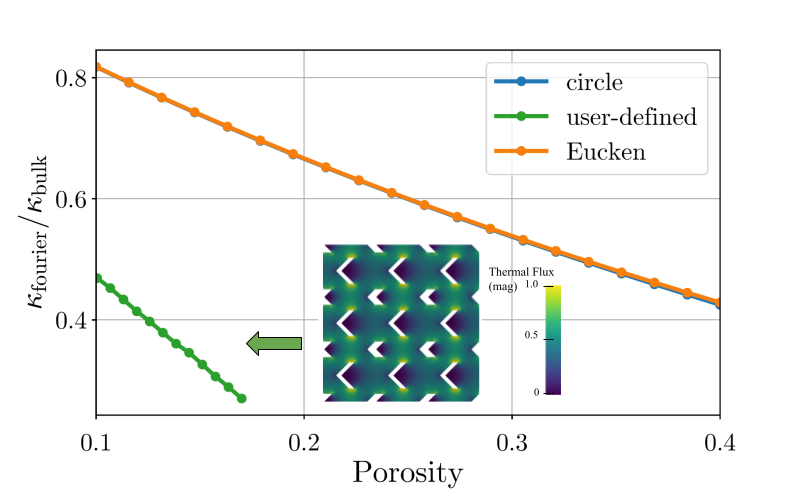
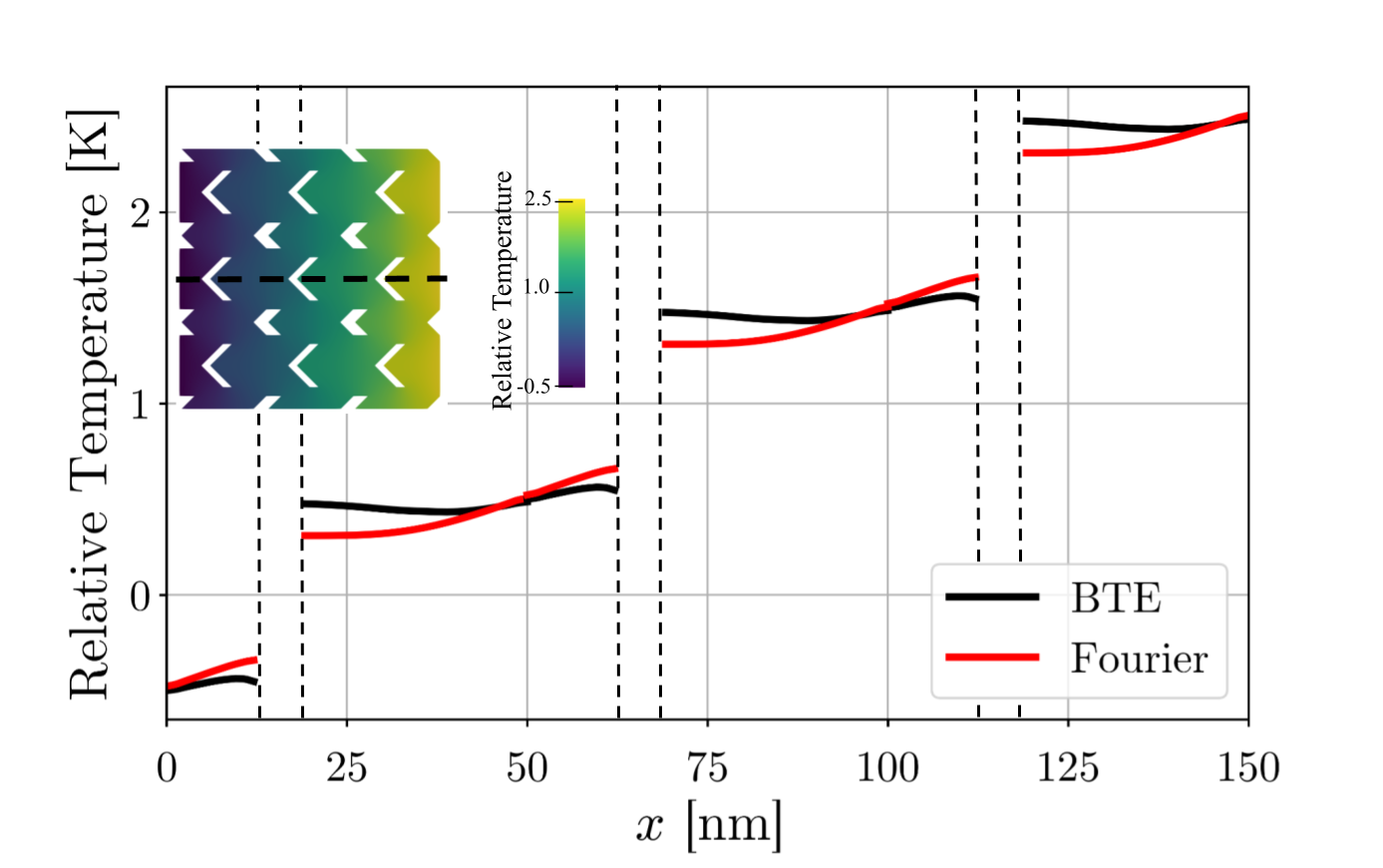
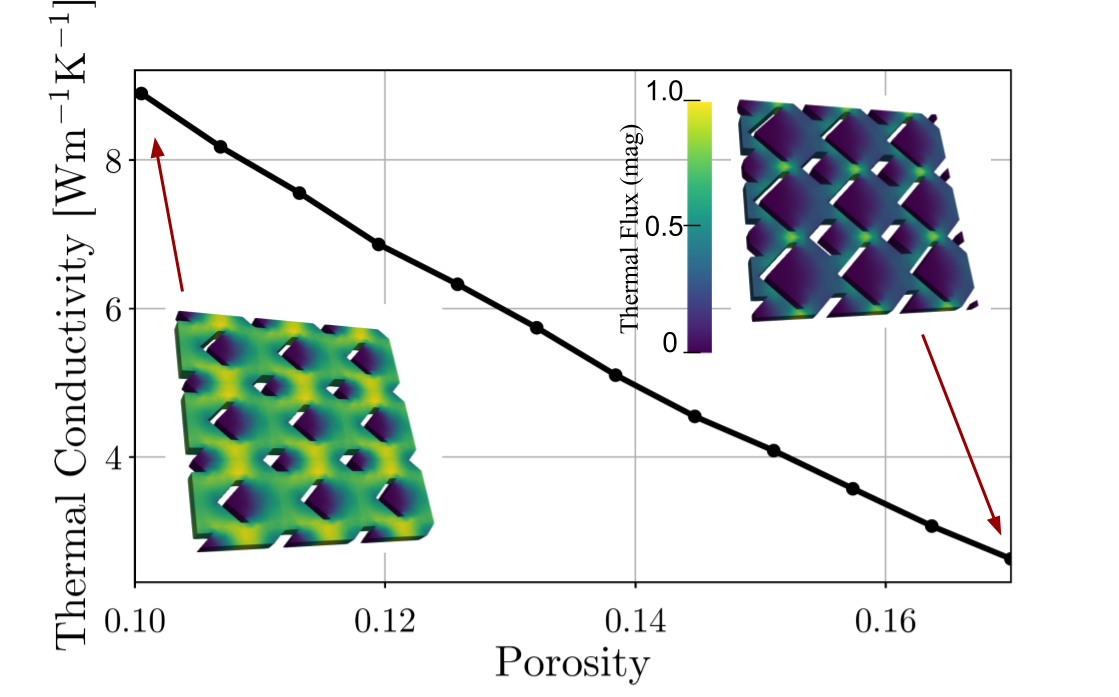
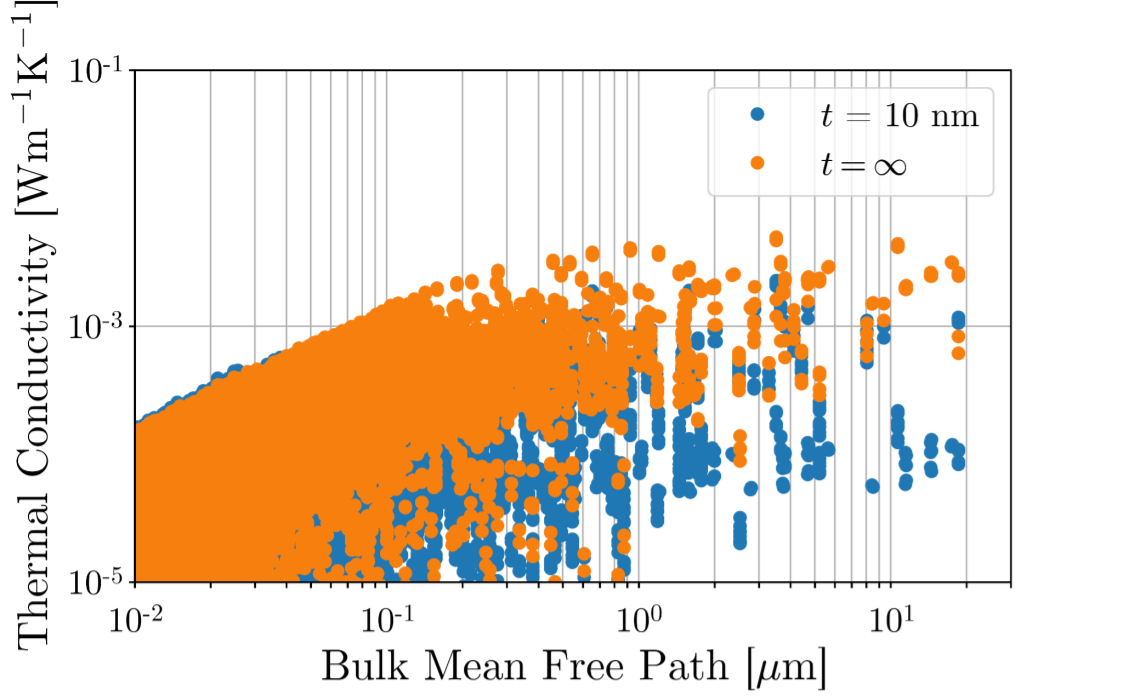
In some cases, it is convenient to use Fourier’s law to estimate macroscopic geometric effects. In this first part, we thus aim to assess the reliability of the diffusive solver, implemented in OpenBTE. To this end, we consider a membrane with circular pores and infinite thickness, for which can be evaluated analytically. In fact, in this case, the thermal transport suppression is given by the Eucken-Maxwell model [33], being the porosity. In Fig. LABEL:fig1a, we compare this model with the results from OpenBTE for different porosities, obtaining excellent agreement (). We note that by using the option only_fourier=True it is possible to run only the Fourier’s model. Next, we compute for a more complicated structure, comprising two concatenated sub-lattices of pores with different user-provided shapes; this structure is generated using the shape=custom option from the lattice model, a two-pore base, and different options for each pore. As shown in Fig. LABEL:fig1a, we obtain a much larger heat transport suppression due to the longest path heat must travel through the material.
Let us now compute using the BTE, encoded in Eq. 4. For the chosen porosity of and = 50nm, we obtain 17.4 Wm-1K-1, well below the corresponding macroscopic value 99.4 Wm-1K-1. In Fig. LABEL:fig1b, we plot a cut of the temperature maps, both for the BTE and Fourier cases, along the -axis. As expected, they have different trends, the BTE one being flatter due to ballistic transport. When a finite thickness is added, phonon undergo stronger suppression; in fact, for thickness =10 nm and porosity 0.1, we obtain W m-1K-1, roughly a half of the value with . In Fig. LABEL:fig1c, for different porosities is plotted. From the insets, we note that, as the porosity becomes larger, the heat flux peaks around the phonon bottleneck, e.g. the areas between the pores. Lastly, the mode-resolved thermal conductivities for = 10 nm and are plotted in Fig. LABEL:fig1d; analogously to Ref. [23], we can appreciate the stronger suppression for large MFPs for the case with finite thickness.
9 Conclusion
We have presented OpenBTE, a software for computing deterministically space-dependent heat transport in 2D and 3D structures. The efficient and modern implementation of the underlying algorithms enable accurate simulations both in the cloud and on common laptops, thus democratizing this type of simulations. Future work includes going beyond the RTA of the BTE and adding transient dynamics. GPU support and differentiability are also on the roadmap. Furthermore, we plan to develop a hybrid Fourier/BTE solver, which has the potential to dramatically reduce runtimes for the cases with 3D structures. Filling an important gap in the current offer of publicly available phonon transport solvers, OpenBTE sets out to guide experiments on nanoscale heat transport and facilitate high-throughput prediction of thermal properties of nanostructures.
10 Acknowledgments
Research was partially supported by the Solid-State SolarThermal Energy Conversion Center (S3TEC), an Energy Frontier Research Center funded by the U.S. Department of Energy (DOE), Office of Science, Basic Energy Sciences (BES), under Award No. DESC0001. The author thanks all the early users, who helped improving OpenBTE.
Appendix A The aMFP-BTE
OpenBTE employs the upwind finite-volume discretization of Eq. 2, where the flux outgoing from volume contributes to the diagonal of the stiffness matrix at row [27]. A sketch depicting incoming and outgoing flux is illustrated in Fig. 4a. The discretized mode-resolved BTE reads [23]
| (6) |
where
| (7) | |||||
| (8) |
arise flux discretization and adiabatic boundary conditions, respectively. The term contributes to the lattice pseudo-temperature; lastly, the perturbation is
| (9) |
The terms , and define the mesh, and are given by
| (10) | |||||
| (11) | |||||
| (12) |
where is the area of the surface between the volumes and , and is its normal, pointing toward the volume . The term is the volume of the element . We solve 6 iteratively,
| (13) |
Equation 13 requires solving as many linear systems as the number of phonons modes. To overcome this issue, OpenBTE implements the aMFP-BTE [23], where the phonon temperatures are interpolated over the vectorial MFPs, ; the chosen are located uniformnly on a spherical grid. The labels and refer to MFP and solid angle, respectively. Analogously, the temperatures are . In the aMFP-BTE formulation, Eq. 13 becomes
| (14) |
where
| (15) | |||||
| (16) |
The term is the perturbation, given by
| (17) |
The quantities and contributes to the lattice temperature and thermal flux, respectively. Finally, after defining in Eq. 14, we obtain Eq. 4. To compute the effective thermal conductivity from Eq. 3, we need to integrate over the hot contact and the momentum space. According to the upwind scheme, the volume from which we pick the temperature depends on whether the flux is outgoing from or incoming to such volume; accordingly, Eq. 3 translates into
| (18) | |||||
where is the ballistic thermal conductivity, being the direction of the applied temperature gradient; the matrices are
| (19) |
where we use , and
| (20) |
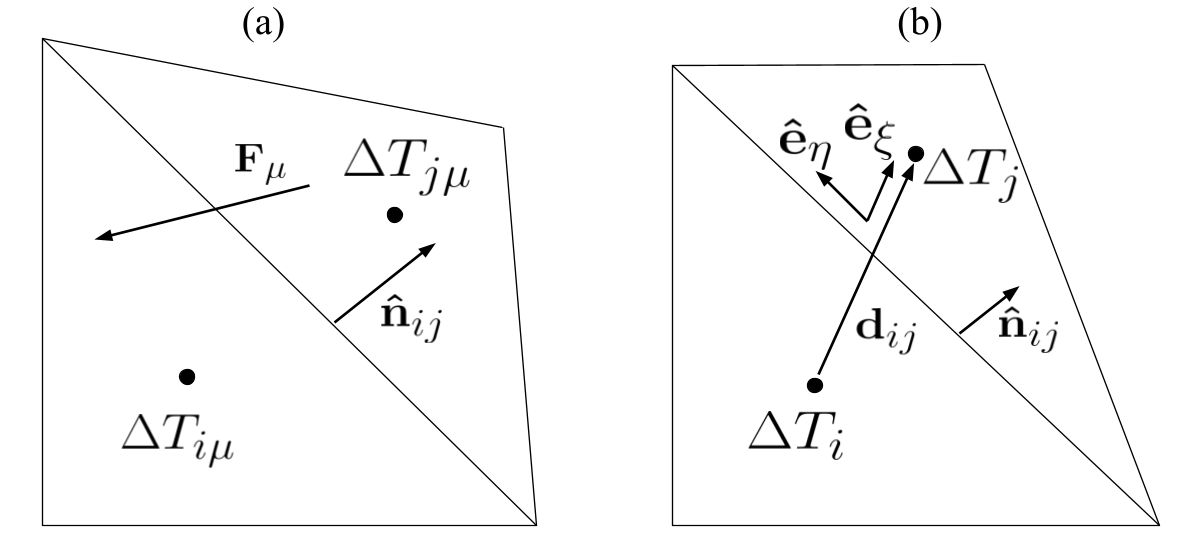
Lastly, it is also possible to compute the “mode-resolved” thermal conductivity, given by
| (21) |
where maps to , and
| (22) |
Appendix B Heat conduction equation
The first guess to Eq. 4 is given by the standard diffusive equation , with being the bulk thermal conductivity tensor. In a finite-volume fashion, we integrate over the control volume
| (23) |
where we used Gauss’ law. Eq. 23 is then transformed into a sum of integrals over individual faces of the volume, i.e.
| (24) |
where and is the gradient evaluated at the face between the volume and (which hereafter will be referred to as ). For orthogonal grids, flux discretization simply leads to , where is the distance between the centroids of the two adjacent volumes. However, for unstructured mesh, a non-orthogonal contribution must be added. In OpenBTE, we follow the approach described by Murthy [27], described as follows. With no loss of generality, we consider a 2D case. As shown in Fig. 4b, we introduce a reference system based on the vectors and . The former is aligned with and latter is parallel to the face. In this new system, the gradient transforms as
| (25) |
with being the Jacobian. Here we will not elaborate on its structure but will only provide the final formula for the temperature gradient [27]
| (26) |
The gradient along at the face is simply
| (27) |
where
| (28) |
Using Eq. 27, we rewrite Eq. 26 as
| (29) |
where is called “secondary flux.” In contrast, Eq. 27 is termed “primary flux.” The secondary flux is treated explicitly, i.e. using precomputed temperatures. To avoid unambiguities in the 3D case, we compute as the difference between the total flux and the primary flux, i.e.
| (30) |
Combining Eqs. 30-29, and explicitly indicating the iteration index, we have
| (31) |
In light of these results, Eq. 24 translates into the following linear system
| (32) |
with stiffness matrix and right hand side
| (33) |
The perturbation term is given by
| (34) |
where . The gradients , appearing in Eq. B, depend on precomputed temperatures. Their calculation if performed by interpolating the gradients from the elements and , i.e.
| (35) |
where
| (36) |
and is the distance between the centroid of the element and the intersection between and the face . The gradient at the element’s centroid is evaluated assuming local linear variation of around the element , resulting in as many linear equations as the neighbours of ,
| (37) |
which, in matrix form, become
| (38) |
Equation 38 is a linear system to be solved for each element. Since has more rows (number of neighbors) that columns (dimensions), we solve it using the least square method, i.e.
| (39) |
Combining Eqs. 39-B and-32, we may formalize the heat conduction equation in unstructured grids as the following iterative linear system
| (40) |
as reported in the main text. Lastly, after Eq. 40 is solved, is computed by
| (41) |
References
-
[1]
L. Lindsay, A. Katre, A. Cepellotti, N. Mingo,
Perspective on ab initio
phonon thermal transport, Journal of Applied Physics 126 (5) (2019) 050902.
URL https://www.osti.gov/pages/biblio/1550742 -
[2]
L. Lindsay, C. Hua, X. Ruan, S. Lee,
Survey
of ab initio phonon thermal transport, Materials Today Physics 7 (2018)
106–120.
URL https://www.sciencedirect.com/science/article/abs/pii/S254252931830141X -
[3]
N. Mingo, D. Stewart, D. Broido, L. Lindsay, W. Li,
Ab
initio thermal transport, Length-scale dependent phonon interactions (2014)
137–173.
URL https://link.springer.com/chapter/10.1007/978-1-4614-8651-0_5 -
[4]
W. Li, J. Carrete, N. A. Katcho, N. Mingo,
ShengBTE:
A solver of the Boltzmann transport equation for phonons, Comput. Phys.
Commun. 185 (6) (2014) 1747–1758.
URL http://www.sciencedirect.com/science/article/pii/S0010465514000484 -
[5]
M. Omini, A. Sparavigna,
An
iterative approach to the phonon boltzmann equation in the theory of thermal
conductivity, Physica B: Condensed Matter 212 (2) (1995) 101–112.
URL https://www.sciencedirect.com/science/article/abs/pii/0921452695000163 - [6] D. A. Broido, M. Malorny, G. Birner, N. Mingo, D. Stewart, Intrinsic lattice thermal conductivity of semiconductors from first principles, Applied Physics Letters 91 (23) (2007) 231922.
-
[7]
K. Esfarjani, G. Chen, H. T. Stokes,
Heat
transport in silicon from first-principles calculations, Phys. Rev. B 84 (8)
(2011) 085204.
URL https://journals.aps.org/prb/abstract/10.1103/PhysRevB.84.085204 -
[8]
W. Li, N. Mingo, L. Lindsay, D. A. Broido, D. A. Stewart, N. A. Katcho,
Thermal
conductivity of diamond nanowires from first principles, Physical Review B
85 (19) (2012) 195436.
URL https://journals.aps.org/prb/abstract/10.1103/PhysRevB.85.195436 - [9] J. Carrete, B. Vermeersch, A. Katre, A. van Roekeghem, T. Wang, G. K. Madsen, N. Mingo, almaBTE : A solver of the space–time dependent Boltzmann transport equation for phonons in structured materials, Comput. Phys. Commun. 220 (2017) 351–362. doi:10.1016/j.cpc.2017.06.023.
-
[10]
Z. Han, X. Yang, W. Li, T. Feng, X. Ruan,
Fourphonon:
An extension module to shengbte for computing four-phonon scattering rates
and thermal conductivity, arXiv preprint arXiv:2104.04895 (2021).
URL https://journals.aps.org/prb/abstract/10.1103/PhysRevB.93.045202 - [11] T. Feng, X. Ruan, Quantum mechanical prediction of four-phonon scattering rates and reduced thermal conductivity of solids, Physical Review B 93 (4) (2016) 045202.
- [12] A. Togo, L. Chaput, I. Tanaka, Distributions of phonon lifetimes in brillouin zones, Phys. Rev. B 91 (2015) 094306. doi:10.1103/PhysRevB.91.094306.
- [13] L. Chaput, Direct solution to the linearized phonon boltzmann equation, Physical Review Letters 110 (26) (6 2013). doi:10.1103/PhysRevLett.110.265506.
-
[14]
L. Paulatto, F. Mauri, M. Lazzeri,
Anharmonic
properties from a generalized third-order ab initio approach: Theory and
applications to graphite and graphene, Physical Review B 87 (21) (2013)
214303.
URL https://journals.aps.org/prb/abstract/10.1103/PhysRevB.87.214303 -
[15]
P. Giannozzi, S. Baroni, N. Bonini, M. Calandra, R. Car, C. Cavazzoni,
D. Ceresoli, G. L. Chiarotti, M. Cococcioni, I. Dabo, et al.,
Quantum
espresso: a modular and open-source software project for quantum simulations
of materials, Journal of physics: Condensed matter 21 (39) (2009) 395502.
URL https://iopscience.iop.org/article/10.1088/0953-8984/21/39/395502/meta -
[16]
L. Paulatto, D. Fournier, M. Marangolo, M. Eddrief, P. Atkinson, M. Calandra,
Thermal
conductivity of bi 2 se 3 from bulk to thin films: Theory and experiment,
Physical Review B 101 (20) (2020) 205419.
URL https://journals.aps.org/prb/abstract/10.1103/PhysRevB.101.205419 -
[17]
M. Simoncelli, N. Marzari, F. Mauri,
Unified theory of
thermal transport in crystals and glasses, Nature Physics 15 (8) (2019)
809–813.
URL https://www.nature.com/articles/s41567-019-0520-x -
[18]
G. Barbalinardo, Z. Chen, N. W. Lundgren, D. Donadio,
Efficient
anharmonic lattice dynamics calculations of thermal transport in crystalline
and disordered solids, Journal of Applied Physics 128 (13) (2020) 135104.
URL https://aip.scitation.org/doi/full/10.1063/5.0020443 -
[19]
L. Isaeva, G. Barbalinardo, D. Donadio, S. Baroni,
Modeling heat
transport in crystals and glasses from a unified lattice-dynamical approach,
Nature communications 10 (1) (2019) 1–6.
URL https://www.nature.com/articles/s41467-019-11572-4 -
[20]
C. D. Landon, N. G. Hadjiconstantinou,
Deviational
simulation of phonon transport in graphene ribbons with ab initio
scattering, J. Appl. Phys. 116 (16) (2014) 163502.
URL https://aip.scitation.org/doi/full/10.1063/1.4898090 -
[21]
J.-P. M. Péraud, N. G. Hadjiconstantinou,
Efficient
simulation of multidimensional phonon transport using energy-based
variance-reduced monte carlo formulations, Physical Review B 84 (20) (2011)
205331.
URL https://journals.aps.org/prb/abstract/10.1103/PhysRevB.84.205331 - [22] A. Pathak, A. Pawnday, A. P. Roy, A. J. Aref, G. F. Dargush, D. Bansal, Mcbte: A variance-reduced monte carlo solution of the linearized boltzmann transport equation for phonons, Computer Physics Communications 265 (2021) 108003.
-
[23]
G. Romano, Efficient calculations of
the mode-resolvedab-initiothermal conductivity innanostructures, arXiv
preprint arXiv:2002.08940 (2020).
URL https://arxiv.org/abs/2002.08940 - [24] G. Romano, Openbte, https://github.com/romanodev/OpenBTE (2013).
-
[25]
G. Romano, Phonon transport in
patterned two-dimensional materials from first principles, arXiv preprint
arXiv:2002.08940 (2020).
URL https://arxiv.org/abs/2002.08940 -
[26]
C. Hua, A. J. Minnich,
Transport
regimes in quasiballistic heat conduction, Physical Review B 89 (9) (2014)
94302.
URL https://journals.aps.org/prb/abstract/10.1103/PhysRevB.89.094302 -
[27]
J. Y. Murthy, S. Mathur,
Numerical
methods in heat, mass, and momentum transfer, School of Mechanical
Engineering Purdue University (2002).
URL https://engineering.purdue.edu/~scalo/menu/teaching/me608/ME608_Notes_Murthy.pdf -
[28]
S. A. Ali, G. Kollu, S. Mazumder, P. Sadayappan, A. Mittal,
Large-scale
parallel computation of the phonon boltzmann transport equation,
International journal of thermal sciences 86 (2014) 341–351.
URL https://www.sciencedirect.com/science/article/pii/S1290072914002233 - [29] C. R. Harris, K. J. Millman, S. J. van der Walt, R. Gommers, P. Virtanen, D. Cournapeau, E. Wieser, J. Taylor, S. Berg, N. J. Smith, et al., Array programming with numpy, Nature 585 (7825) (2020) 357–362.
-
[30]
L. D. Dalcin, R. R. Paz, P. A. Kler, A. Cosimo,
Parallel
distributed computing using python, Adv. Water Resour. 34 (9) (2011)
1124–1139.
URL https://www.sciencedirect.com/science/article/pii/S0309170811000777 -
[31]
C. Geuzaine, J.-F. Remacle,
Gmsh: A 3-D
finite element mesh generator with built-in pre-and post-processing
facilities, Int. J. Numer. Meth. Eng. 79 (11) (2009) 1309–1331.
URL http://onlinelibrary.wiley.com/doi/10.1002/nme.2579/full -
[32]
J. Ahrens, B. Geveci, C. Law, Paraview: An
end-user tool for large data visualization, The visualization handbook
717 (8) (2005).
URL https://www.paraview.org/ -
[33]
D. Hasselman, L. F. Johnson,
Effective thermal
conductivity of composites with interfacial thermal barrier resistance, J.
Compos. Mater. 21 (6) (1987) 508–515.
URL https://aip.scitation.org/doi/full/10.1063/1.4945776